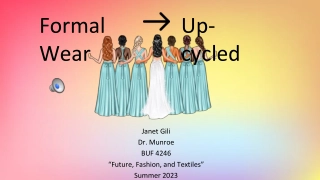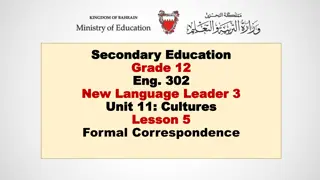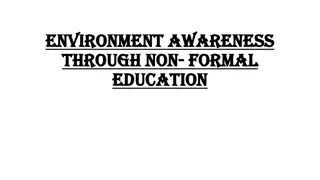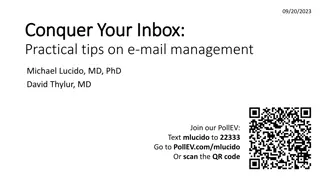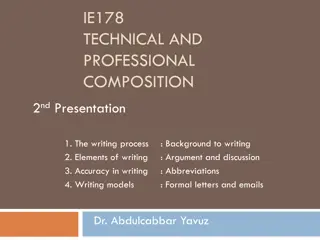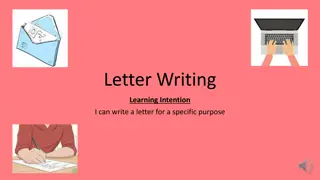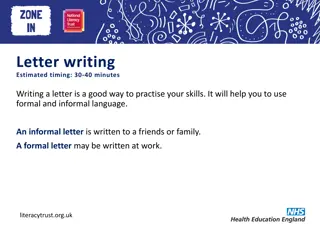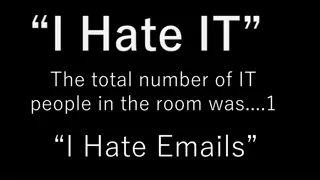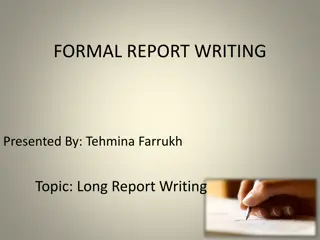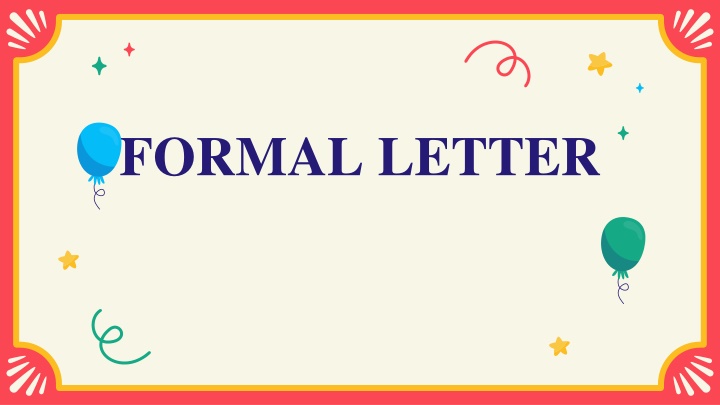
Effective Tips for Writing a Formal Letter
Discover how to craft a well-structured formal letter by including essential elements such as addresses, greetings, and body content with the right tone. Learn the correct format for starting a formal letter, from including contact information to creating a concise body. Master the art of formal letter writing for various purposes like job applications, complaints, and inquiries.
Download Presentation

Please find below an Image/Link to download the presentation.
The content on the website is provided AS IS for your information and personal use only. It may not be sold, licensed, or shared on other websites without obtaining consent from the author. If you encounter any issues during the download, it is possible that the publisher has removed the file from their server.
You are allowed to download the files provided on this website for personal or commercial use, subject to the condition that they are used lawfully. All files are the property of their respective owners.
The content on the website is provided AS IS for your information and personal use only. It may not be sold, licensed, or shared on other websites without obtaining consent from the author.
E N D
Presentation Transcript
WHAT IS A FORMAL LETTER? A formal letter is a type of written communication that sticks to a set structure and tone. It includes specific elements like the sender s and recipient s addresses, a formal greeting, and a closing statement. Formal letters are often used for job applications, official complaints, or business inquiries.
HOW TO START A FORMAL LETTER 1. Include your name and contact information The return address should be written in the top right-hand corner of a formal letter. This will usually your address but could be any other address to which a reply should be sent. 2. Include the recipient's name and address Add the address of the person you are writing to. The recipient's address should be written on the left, often starting below your address.
HOW TO START A FORMAL LETTER 3. Include the date There is no strict rule about the placement of the date, but it can be placed on either the left or right side of the page after the recipient's address. Write the month as a word. 4. Use the right greeting or salutation If you know the name of the person, you're writing to then use 'Sir' or 'Madam' here, otherwise write their full name, including their title. Remember, try not to be too informal or casual. E.g.: 1. Dear Sir / Madam
4. Use the right greeting or salutation If you know the name, use the title (Mr., Mrs., Miss or Ms., Dr, etc.) and the family name only. If you are writing to a woman and do not know if she uses Mrs. or Miss, you can use Ms., which is for both married and single women. E.g.: 1. Dear Mr. Jenkins, 2. Dear Ms. Hammers, 3. Dear Mrs. Hutchins, 4. Dear Miss Davis, 5. Dear Dr Green,
HOW TO START A FORMAL LETTER 5. Create the body of your letter The body content should be clear, concise, and relevant to the purpose of the letter. It should not include any unnecessary information or informal language. Be direct and try to keep it as brief as possible, often between three or four paragraphs in total.
HOW TO START A FORMAL LETTER 5. Create the body of your letter The first paragraph should be kept short and is designed to introduce you and to state the purpose of the letter- to make an enquiry, complain, request something, etc. The paragraph or paragraphs in the middle should contain the relevant information behind the writing of the letter. Most letters in English are not very long, so keep the information to the essentials and concentrate on organizing it in a clear and logical manner rather than expanding too much. The last paragraph should state what action you expect the recipient to take- to refund, send you information, etc.
HOW TO START A FORMAL LETTER 6. Close the letter with a formal sign-off If you do not know the name of the person, end the letter using 'Yours faithfully . If you know the recipient's name, use 'Yours sincerely . 7. Add your signature Sign your name, then print it underneath your signature using capital letters (or type it). If you think the person you are writing to might not know whether you are male of female, put your title in brackets after your name. Optionally, it can also be helpful to include your phone number and email address. 8. Proofread Now that you've completed the first draft, read if over from start to finish and check for any errors in grammar and spelling. Make sure it reads well and that the recipient will understand what the letter is about.
Keep in mind while writing formal letters Short and crisp Get to the point Use formal words Don t be too casual Be polite Use powerful words If there are crucial information like numbers, amount, date and time or venue. Mention it clearly.
Reason for writing You have to have some reasons to contact the other person. State your reason short and to the point of why you have to send this email. Use this I am writing to make a reservation I am writing to apply for the position of . I am writing this letter to confirmmy booking I am writing this letter as for the confirmationof my reservation I am writing to ask for more information regarding . With referenceto our conversation on last Friday, I would like to ask for the progress I would like to let you know that .
Making a request / Asking information Use these sentences Could you please let me know if you can attend ? Could you please let me know if you are available for a meeting on 12thof December? I would like to inquirefor your kind consideration for . I would like to ask for your kind permission to allow me to I would like to know if there are any swimming pool in your area.
I S Y 3 6 0 1 E n g l i s h f o r I n f o r m a Offering help / Giving information Try these sentences Weare happy to let you know that . Weare glad to informyou that Should you need further information please feel free to contact me via this letter. Please contact me if you need further information. In case there is any need of assistance, please contact me via this letter.
Complaining about something Use these phrases I m writingto complain about I feel sorry to write this complain but it is necessary to inform you that I regret to say that I am completely not satisfied with the service I got yesterday. I am tremendously dissatisfied with the service I got from your shop this evening. I would like to request for a full refund for the damage caused during the delivery of the product.
Apologizing Use these phrases I m sorry to informyou that I regret about my recent behavior to you. I would like to apologize for any inconveniencecaused. Please accept my apology for the delay in delivery. The company will take full responsibilityfor the damage caused on your product. I will see to it that this kind of event will never happen again in the future.
Use of powerful and polite words Instead of this Use this I want to I would like to I want to ask you about the event. I would like to inquire you regarding the event. I want to have permission. I would like to inquirefor the permission. I amsorry. I apologize. I amvery sorry. I sincerely apologize. I thank you very much. I amextremely grateful to you. I want to ask you to do this for me. I would like to request you to kindly do this for me I amsorry if I troubled you. I apologize for any inconveniencecaused. I want you to think about allowing this I would like to request for your kind consideration
Ending the letter Polite ones Normal ones Sincerely, Sincerely yours, Affectionately yours, Yours cordially, Respectfully yours, Yours faithfully, Yours truly, Regards, Best regards, Thanking you, Warmregards, Kind regards, Thank you for your consideration,
Exercise 1: Rearrange the sentences to form a coherent thank-you letter. Write the correct order of the sentences. a. Once again, thank you for your support. b. The contribution you made will make a significant impact on our cause. c. Your support means the world to us. d. Thank you so much for your generous donation. e. We are incredibly grateful for your kindness. f. I am writing to express my deepest gratitude.
Exercise 2: Rearrange the sentences to create a coherent apology letter. Write the correct order of the sentences. a. I value our friendship and hope you can find it in your heart to forgive me. b. Please accept my sincere apologies for any distress I may have caused. c. I am writing to apologize for my behavior at the party. d. It was completely inappropriate, and I deeply regret my actions. e. I assure you that it will not happen again. f. I understand that I hurt your feelings and caused embarrassment.
Exercise 3: Rearrange the sentences to form a coherent permission letter. Write the correct order of the sentences. a. I am writing to request permission to use the school auditorium for our charity event. b. We will be grateful for your support and the opportunity to host the event at our school. c. We have a dedicated team of volunteers who will ensure that the event runs smoothly. d. Please let us know at your earliest convenience if the auditorium is available on the specified date and time. e. The event is scheduled for Saturday, June 15th, from 2 PM to 6 PM. f. The charity event aims to raise funds for underprivileged children in our community.

